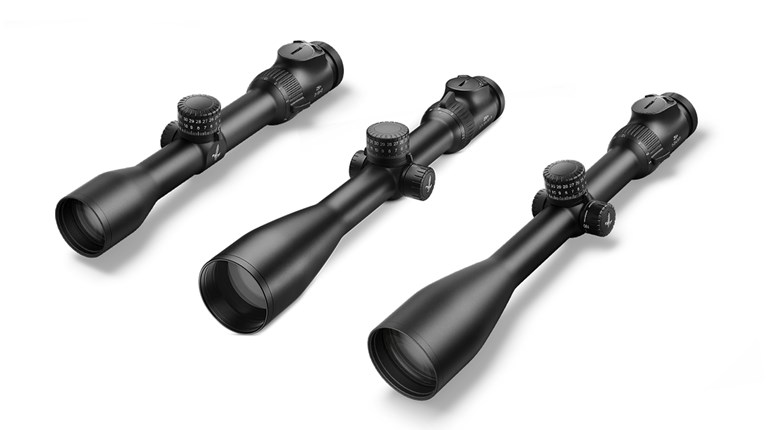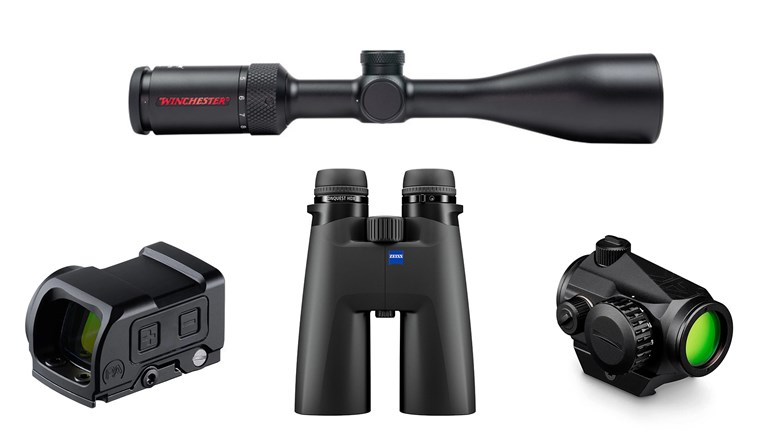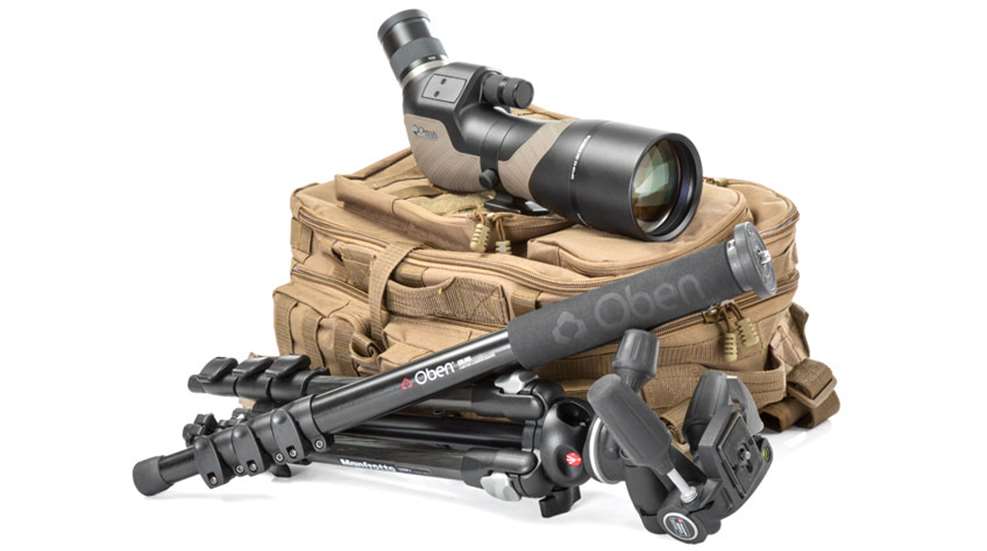
You know the guy—the one who drives everyone crazy on the range. There you are, settled into your firing lane, working on a killer group, focused on your sights, squeezing smoothly and deliberately when suddenly you hear “Hey folks, I need to go cold again” for the 30th time in the past hour. Yeah, that guy. Every range has one. Hopefully it’s not you.
Then there was that time you were trying to hit a steel gong at 450 yards with your brand-spanking-new rifle—the one you could not wait to show off to your best shooting buddy. Unfortunately, the red-dot sight you mounted provided no feedback for hits and misses at that distance. You kept banging away without hearing the satisfying sounds of projectiles flattening out against ballistic steel. You looked back for help, and your iron-sighted range mate just shrugged. You held your dot on the top edge, then a foot high, 5 feet high, a foot left, 2 feet right and even low “just in case.” Other than a big “dirt buffalo” that the last shot kicked up, every other projectile could have gone into a black hole between you and the target for all you knew. Your round count was high, your blood pressure was higher and coffee shot out of your buddy’s nose. You can still hear him laughing today.
Unless you are blessed with the eyes of a hawk, shooting at 100 yards and beyond presents challenges when you need to see where your shots go. A magnified riflescope can help, but they have limitations, too. Both of the above scenarios could have benefitted from the addition of a device used specifically for observing targets, impacts, misses and anything else downrange—most often a spotting scope. Brushing up on the art of spotting can go a long way toward making you a better shooter and a more-bearable range partner.

Equipment
Effective spotting revolves around an optical device of good quality. It should allow you to see downrange in greater detail than your eyes or the sight(s) on your rifle are capable of. Spotting scope prices range from around $25 for the cheapest imports to several thousand dollars for premium quality, tactical spotters. I used everything from 1940s-era spotting scopes to the premium stuff as an Army sniper, and optical quality was excellent in all of them. My budget is pretty modest today, but I still avoid the cheap stuff because no matter how good they look in advertising, low-end optics fall apart quickly and have lenses that make beer-bottle glass look good. Fortunately, there are a bunch of decent spotting scopes in the low-to-middle hundreds range. A decade ago I paid around $200 for a Leupold Sequoia 20-60X spotting scope. It served me well through weekly use until finally breaking last spring. It was replaced by Bushnell’s new Legend T Series 15-45X spotter, which retails around $450. While not inexpensive, the first-focal-plane-equipped Bushnell shares many features with tactical spotting scopes that cost three times as much. Optical quality is not quite as clear at the edges, but it is good enough for everything I need it to do.
Variable-power spotting scopes allow you to dial power down when needed. That can be handy at dawn or dusk, where less magnification results in brighter images. Dialing down power can also help you see targets more clearly in high-mirage conditions and provide a wider field-of-view for observation. Optics in the 20X to 60X range are most common, but lower and higher ranges are available, accompanied by proportional changes in scope size and weight. Whenever possible, take a good look through a spotting scope before buying it, preferably outside and at some distance. Looking through one in a store will only remind you why most spotting scopes are not meant to be hand-held. One way to try before you buy is to volunteer to “help” on the range by spotting for others through their scopes. Look for an optic with clear images from edge to edge and ergonomic controls that do not require you to come all the way out of position to manipulate.
Conventional spotting scopes need support to help stabilize them. Tripods are the most common way to do it, especially at a static range. Shooting sticks can be used, as can a daypack, bag rest and even steady tree branches when you need to get higher sight lines. But, it is very hard to hold a high-magnification optic still enough to see the detail needed, which is why tripods excel for this purpose. Dialing down to a lower power helps to remove some of the wobble you see when working with less-than-ideal support.
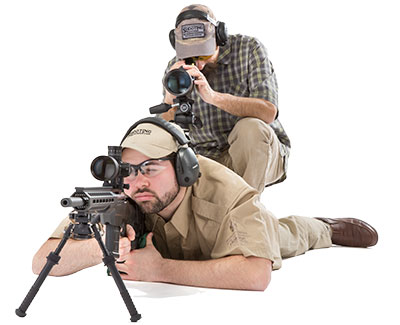
Range Use
Short-range spotting to see shots on paper is pretty simple. Set your optic alongside you on the firing line—either on a bench or the ground if prone—and resist the urge to check every shot you fire. Just like a riflescope, dialing down power when heat and mirage are high often allows for a clearer view of the target, especially when hunting for small-caliber bullet holes beyond the 100-yard line. Take care to position the scope where muzzle blast, blown debris and flying brass will not hit the lenses. The larger the holes your projectiles make in a target, the farther away you can discern them through magnified optics. Apply a fresh coat of light-colored paint to steel targets to best observe hits on them from afar.
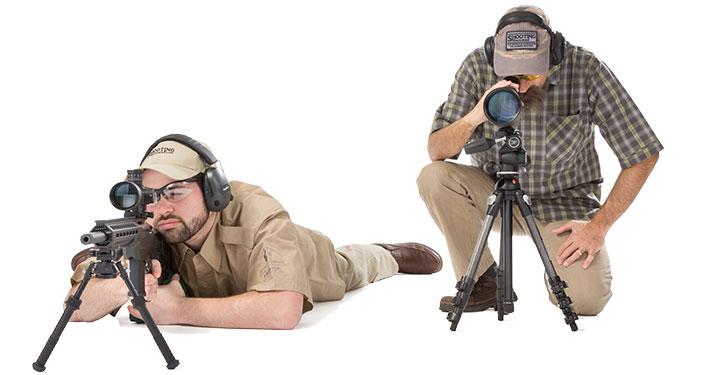
Buddy System
Working in pairs enables real-time feedback for the shooter. A dedicated spotter can help you identify a good target to shoot at, double-check your range settings, let you know what the winds are doing and (ideally) give you immediate feedback after every shot. In the sniping world, there are additional bits of information exchanged by the shooter and spotter, but for basic buddy-assist work at the range, keep things as simple as possible.
Long-range shooting provides the spotter an opportunity to watch a bullet’s track through the air, commonly referred to as “trace.” As air is compressed at the leading edge of a moving bullet, it creates a disturbance that is visible under the right lighting conditions. This bullet trace is usually easier to spot when there is a lot of moisture in the air. When you do see trace, it is most likely going to be in the last moments of a bullet’s “flight” to the target. It is easy enough to track the windage, but judging a bullet’s impact elevation near the target is more challenging. Trace tends to disappear above a far target as it drops in at the end of the trajectory’s path, or falling branch. Sometimes it helps to change the focus of a spotting scope to a point around 2/3 the distance to the target if you are having trouble seeing trace. Another tip is to position the spotter as close to directly behind the shooter’s line of fire as possible. This allows for sighting along the same line to the target, greatly increasing a spotter’s ability to observe trace. It’s easy if you know where to look, but reading it accurately takes a lot of practice to master. That is one reason why professional long-range shooters tend to position the more-seasoned member of a pair in the spotter role.
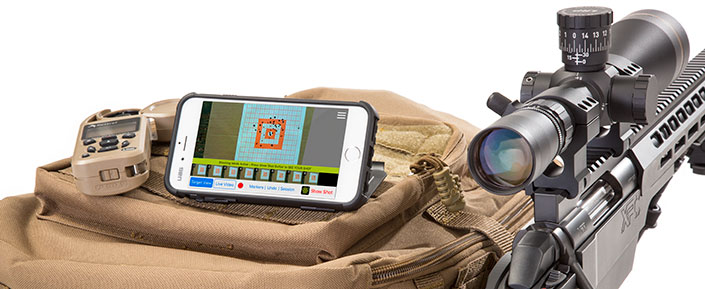
Techno Trends
Electronic target-monitoring systems have been around almost as long as video transmission has existed. But receiving those images wirelessly, in real time, up to 2 miles away directly to your smartphone is the cutting edge of target-observation technology. Hard-wired systems are still a good option for fixed ranges, but mobile units are quickly taking over the market. Both systems give shooters the ability to see hits on targets at distances far beyond spotting-scope ranges and take many of the variables that affect optical clarity out of the picture due to their close placement to targets. The use of smartphones makes it easy to record videos and stills of the action for later study. Simple brackets are available that allow attachment of smartphones and cameras to the backs of normal spotting scopes, too. Entry-level wireless systems start at around $175, and setups that work out to one mile start around $350 and go into the thousands as quality and features increase.
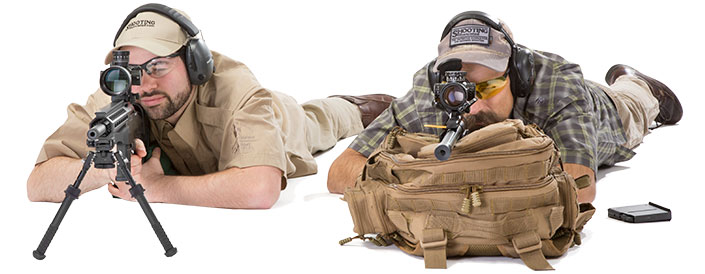
Field Notes
Spotting in the bush requires most of the same techniques and equipment as does flat-range spotting, but with some minor tweaks. Since we are not looking for holes in paper targets or watching for “splash” on steel, field spotting is oriented more heavily toward actions before the shot and making quick adjustments for any misses. Here again, buddy teams benefit from the use of a spotting scope, but vegetation often requires more elevation above the ground than is needed on a flat range. Long-legged tripods are not real practical, but one that can elevate a scope 18 to 24 inches when fully extended is a good compromise between size and portability. Collapsible shooting sticks or a monopod provide more flexibility and speed of placement, but provide less stability. In dense brush it is virtually impossible for shooter and spotter to use the same sight line. Sometimes just finding a pair of decent “loopholes” to see through is enough of a challenge.
Binoculars work particularly well for spotting in field settings or anywhere that mobility and good situational awareness are critical. They are more forgiving for hand-held use due to their typically lower powers and better ergonomics. Conventional binoculars are relatively stable when you sit Indian-style, with your knees raised up to support your elbows. In the late 1990s my Army unit began using Canon stabilized binos for reconnaissance duties. Since we snipers did all the recce work, we quickly realized these binoculars were perfect for observing shots, too. We had various powers available and made very good use of them abroad.
Communication
It pays to rehearse a few common terms and procedures with a shooting partner before spotting for each other. Use simple, concise words for direction, distance and target descriptions. Clock direction—with the line of fire always being 12—is a good starting point. If the spotter is going to give wind holds, moving target leads or corrections for missed shots, use measurements that make sense to both of you. A spotting scope with a reticle similar to the shooter’s makes it easy, essentially allowing you to speak the same visual language. A simpler way to do that is to spot for each other using riflescopes only. In this case the spotter offsets slightly to the side (to keep from flagging the shooter with the spotter’s muzzle) and uses his or her own riflescope reticle to handle any measurements or corrections.
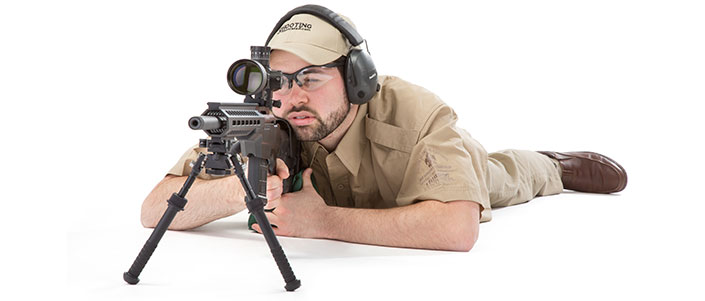
Self-Spotting
The traditional two-man team shooter/spotter team is the foundational element taught in military sniper schools. But real-world tactical life is seldom simple enough to allow that luxury. Small, specialized teams may train as shooter and spotter, but they are often forced to self-spot in order to cover multiple directions simultaneously in a dynamic threat environment. Self-spotting is an advanced technique, but is not limited to the tactical world. You just need a riflescope with enough magnification to view bullet impacts at whatever distances you intend to shoot. More importantly, your shooting technique has to be rock-solid. Follow-through after the shot is more critical than usual, as you must be looking at your point-of-aim when the projectile reaches it. The farther the shot, the easier it is to self-spot due to longer times-of-flight that allow you to recover from recoil forces. Whether you hit or miss, seeing the impact will tell you what to do next. A good reticle with detailed mil- or MOA-based subtensions will allow you to measure the distance from a miss to your intended point-of-impact and correct very quickly. In the right conditions, you might even get a glimmer of trace above your target just before impact—but do not go looking for it. Instead, follow through on the target normally and be ready to follow-up as needed.
I went through my formal sniper training a little more than 20 years ago. My partner was and is still one of my best friends. I enjoy reminding him that I beat him for the Top Shooter and Distinguished Honor Grad awards by eight-tenths of a percentage point. The joke we share is on me, though. You see, for most of the course we spotted for each other, including during all but one of the scored evaluations. The miss that cost him that fraction of a point was due to my bad wind call, not his shooting. He was a better spotter for me than I was for him. They do not give a “Top Spotter” award, but if they did, it would be the one to aim for. You can train a monkey to pull a trigger, but effective spotting is where the real challenge begins.














